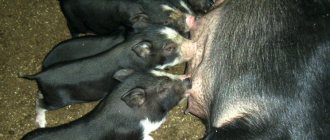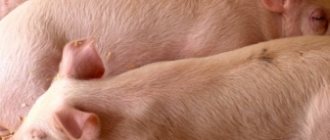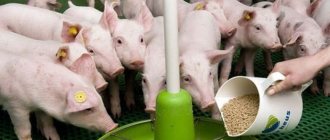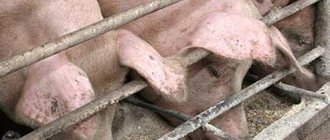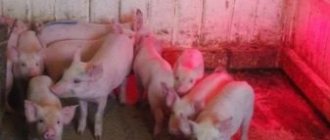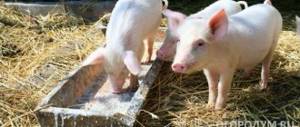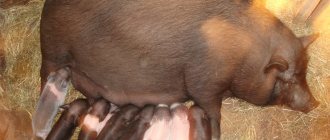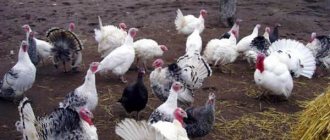published: 02. 02. 2021
author: Sergey Kuznetsov
From this article you will learn:
- What types of pig fattening are used on farms?
- What diet is best for fattening pigs?
- What are the periods for fattening pigs?
- What are the features of fattening pigs at home?
- How effective is the use of premixes for fattening pigs?
Domestic and industrial pig farming is aimed at producing meat and lard. For each of these purposes, a special diet for feeding animals is selected. There are several factors that can help a livestock producer speed up or slow down the fattening of pigs. In the article we will tell you what types of fattening exist, what the diet of pigs should be and how to formulate it correctly.
What should be the diet for fattening pigs?
Depending on the type of diet, the livestock breeder calculates how much feed the pig needs for fattening. The diet of beef-fed animals largely consists of protein feed. Fat fattening pigs are given more carbohydrate foods. Individuals used for bacon production are given both types of food.
Feed directly affects the quality of the resulting pork.
The following product groups are distinguished
- To improve the quality of pork. These are barley, rye, wheat, millet, beans, peas, silage, beets, carrots, green feed (clover and alfalfa), and dairy products.
- Softening lard, but reducing its taste. These are corn, buckwheat, potatoes, wheat bran.
- Reducing the quality of pork: oats, soy and fish products. These products can be fed in small quantities. A month before slaughter, they must be removed from the pigs’ diet, otherwise the meat will have an unusual taste and smell.
The best feeding for pigs, which allows you to get good pork, is 50% of products from the first group and 50% from the second.
Fattening periods for pigs
The life cycle of pigs from the beginning of fattening to meat production is divided into three stages:
- From birth to 8 months. The development of organs, bone tissue and muscles is observed. At this time, the diet of young pigs for fattening is supplemented with the feed that will constitute their diet in the next period.
- From 8 to 14 months. The growth of muscles, bone tissue and organ development stops, and active growth of adipose tissue begins. During this period, the amount of food in the diet increases and it becomes more nutritious. It is necessary to increase the costs of pumpkin, potatoes, beets and concentrates.
- From 14 months to slaughter. The development of organs and bone tissue is completely completed. It is necessary to maintain normal metabolism in pigs, which is done by introducing proteins and minerals into the diet. However, their quantity should not be excessive in order to avoid animal obesity. Often, culled individuals are selected for fat formation. After finishing feeding, they quickly gain weight (the fattening period for these pigs is 23 months).
Fattening for meat
The beginning of this method of keeping is marked when the piglet reaches 3 months of age and continues until a body weight of 100-120 kg is gained.
There are two types of fattening piglets for meat at home:
- Low-intensity . It is characterized by a lower level of growth during the day, when at the end of fattening the pig can gain weight not exceeding 100 kg over a fairly long period of time. Such fattening becomes justified in the presence of abundant amounts of cheap feed of low nutritional value.
- Intense . This method of maintenance is considered the most profitable. In this case, piglets are raised at the age of 3 months, the average weight of which is 30 kg. They are fattened for 4 months. In the case of proper nutrition, the net weight gain is 90 kg. Intensive meat fattening of pigs requires a dry and warm room for pigs. Also of no small importance is the high appetite of individuals and a balanced diet of fattening pigs.
Meat fattening of pigs is characterized by two main periods:
Preparatory
Characterized by longer duration. The most favorable periods are the summer and spring seasons, during which it becomes possible to use green feed in large quantities. This type of food should account for about 30% of the pork diet. With the onset of summer, the choice of food expands and there is a lot of it. When cold weather sets in, summer feed is replaced with silage and grass flour with the addition of root vegetables. During this period, it is necessary for the animals to gain weight.
If there is a lack of protein, the growth of piglets slows down, causing early obesity, as well as a decrease in the quality of meat. Mineral supplements and vitamins A, B and D are important. In addition, feed should be rich in amino acids. Feeding pigs correctly means being confident of large weight gains with relatively low feed consumption.
Finite
At the final stage of fattening, it is important to increase the concentrated mass until 90% of the nutritional value is reached. Moreover, in the case of using potatoes as fattening, it should account for one half of the nutrition, and the second should consist of concentrate. Other foods with a juicy consistency will also be an excellent alternative to potatoes.
It is permissible to add 40 grams of salt to the diet, which promotes a good digestive process and digestion of nutritional compounds. However, there is no need to increase its quantity. In order to maintain the balance of vitamins in the body, it is necessary to use grass flour, feed yeast and vitamin concentrates.
Fattening pigs for meat involves feeding them twice a day, and the presence of pure water in drinking bowls is mandatory. Silence is maintained in the pig pens, since it is better not to disturb the young animals unnecessarily. During the final months, the duration of walking in the fresh air is reduced, and the pig pen is darkened.
Technology for fattening pigs at home
Many livestock breeders add special additives to the feed that accelerate weight gain in pigs.
Home fattening pigs may include drugs to stimulate growth. An additional benefit of these supplements is that they protect animals from disease and inflammation.
Examples of such drugs:
- Etonium. When taking it, the animal grows, while the amount of feed consumed can be reduced. Moreover, such pork has a more pronounced taste.
- Amylosubtilin GZH. This is an enzyme preparation that increases fat deposits and allows you to reduce the amount of feeding to fattening pigs.
- Betazin. Accelerates the growth of animals and allows you to reduce the amount of feed.
Feeding pigs at these complexes can also be used to improve the growth rates of those individuals who, for one reason or another, are lagging behind in development.
The listed drugs are dissolved in water and then added to the feed. If antibiotics are used as stimulants, then vitamin complexes must be fed to the animals along with them. This way the pigs will receive all the important nutrients.
Liquid solutions with stimulants are added to wet mash, premixes and mixed feed.
How effective is feeding pigs with premixes?
Food when fattening young pigs directly affects the quality of meat and lard, as well as the amount of pork produced. Today, feeding pigs with premixes is very popular, which significantly reduces feeding time.
Premix is a special food additive that is used for raising pigs. This component includes important nutritional elements needed by the animal depending on the period of life. These are minerals, vitamins, prebiotics, amino acids, etc.
To keep the cost of pork lower, livestock farmers introduce special feed and premixes into the feed. These additives help reduce feed costs and improve their digestibility.
Additional elements for better digestibility of feed are enzymes and enzymes. To improve the quality of the diet, livestock farmers add adjuvants, adsorbents and zeolites to it. These substances absorb harmful toxins from food, kill fungi and bacteria.
The composition of feed for fattening pigs must contain wheat, barley, potatoes, tops, and waste from which mash is prepared. Before the grain is given to animals, it is steamed. The resulting thick porridge is fed to pigs. When using premixes, it is necessary to mix millet or barley with protein-vitamin-mineral supplements in an amount of 4:1.
For each period of a pig’s life, its own diet is calculated, taking into account age-specific nutritional requirements for food. In addition to mother’s milk, piglets are given special “baby feed”. It is administered from 5 days of age. When the pig reaches the age of 2–4 months, it is transferred to feed with premixes. 4 months is the age when fattening can begin. It continues until the individual weighs 100 kg (about 9 months old).
By including premixes in compound feed for fattening pigs, you increase the daily weight gain by 30%. This allows you to significantly reduce the entire fattening period, and as a result, reduce the cost of pork. Moreover, premixes improve the taste of meat.
To achieve high-quality pork, it is necessary to comply with all animal feeding requirements, as well as sanitary and hygienic standards for their care. The use of compound feed is more profitable for the producer, however, it must be taken into account that physiologically pigs are not adapted to the consumption of crushed feed. Therefore, we have many cases where pigs developed stomach ulcers during industrial fattening.
ANALYSIS OF FACTORS IN PIGS FATTERING TECHNOLOGY AFFECTING THE QUALITY OF MEAT SOLD article
ANALYSIS OF FACTORS IN PIGS FATTERING TECHNOLOGY AFFECTING THE QUALITY OF MEAT SOLD
Modern pig farming is a highly developed branch of animal husbandry with enormous production potential. Based on scientific achievements in the field of pig breeding, existing pig breeds have been improved and new highly productive breeds of pigs have been created in many countries of the world, and effective technologies for pork production have been developed under continuous production conditions in large industrial complexes and small farms.
In terms of precocity, animal fertility, meat and fat yield, pig breeding ranks first among livestock sectors. By the age of 8 months, the piglet’s weight increases approximately 100 times.
Among farm animals, pigs are distinguished by their high slaughter yield: in young animals it is 70-75%, in adult animals - 80-85%.
Pork meat is distinguished by a high content of complete and easily digestible protein and essential amino acids. The digestibility of pork meat in the human body is 90-95%, and pork fat - 97-98%.
The quality of pork varies depending on the age, fatness and breed characteristics of the animals, as well as the feed they consume and living conditions.
Feeding affects the development, growth rate, body weight and reproductive functions of the animal. Only with full provision of animals with high-quality feed can pig farming be successfully developed. Of all environmental factors, feeding has the greatest influence on productivity. In the structure of the cost of pig production, the share of feed in pork production is 50 - 55%.
Therefore, it is relevant to study the strength of the influence of feeding on the quality of sold pork.
The purpose of our work is to analyze factors in pig fattening technology that affect the quality of meat sold.
The tasks of the work include:
- Conduct a theoretical analysis of pig rearing;
- Describe the methods and methods of fattening pigs;
- Analysis of factors in fattening technology affecting the quality of meat.
In the first chapter of our thesis, we conducted a theoretical analysis of raising pigs. Due to a number of biological features, pig farming, as a branch of livestock farming, has one of the leading places in solving the meat problem. Such biological features include precocity, short fruiting period, multiple births, and high economic efficiency of fattening.
Scientists have repeatedly emphasized the striking anatomical and physiological similarities between pigs and humans. They have a lot in common in the structure of the intestines, genitourinary and cardiovascular systems, respiratory organs and even skin. Thus, the weight of the heart in a pig is 320 g, and in a person - 300, the weight of the lungs is 800 and 790, respectively, the kidneys - 260 and 280, the liver - 1600 and 1800 g. The number of heart beats per minute in a person is 60-90, in a pig 62-80 .
Multiple pregnancy is the main biological feature of sows.
Multiple births are determined by the number of live piglets in the nest at birth. For breeding scientific purposes, the fertility of queens is also judged by the number of all live and dead (including mummified) piglets born at each farrowing. This productivity indicator in domestic pigs varies between approximately 7-16, and most often 9-13 piglets per farrowing. In pig farming practice, cases of up to 30 piglets being born during one pregnancy (two farrows with an interval of one day) have been recorded.
Multiple births are inversely related (negatively correlated) with the average weight of each piglet (or total weight of the nest) at birth. It has breed characteristics, expressed in a decrease (7-9) or increase (10-12) of piglets on average per farrowing.
Precocity is determined by the speed at which an animal reaches sexual and economic maturity. A pig can be covered at 9-10 months, and give birth to the first litter at 13-14 months. Early maturity is understood as the ability of pigs to reach a level of development that allows them to be used for reproduction and production of meat products in a short time. Modern breeds and technologies for fattening pigs make it possible to achieve a live weight of 100-120 kg in 180-190 days and an average increase in live weight of 800-900 g over the entire fattening period.
The slaughter yield of pigs is higher than that of other types of farm animals. Thus, the slaughter yield of fattened pigs is 75-82%, while for cattle it is 50-60%, and for sheep it is 44-52%.
Pork is the most easily digestible meat after lamb, and pork fat is much less harmful than beef for the heart and blood vessels.
The digestibility of pork meat reaches 95%, lard 98%. The calorie content of 1 kg of pork of average fatness is 8100 kcal, while beef and lamb of average fatness are 1500-1550 and 1200-1300 kcal, respectively.
In the second chapter of the work, we looked at the methods and methods of fattening pigs to produce pork.
Fattening pigs is the final period in pork production. The level of productivity of pigs, the quality of the product produced and the profitability of pig farming largely depend on its correct organization.
There are many methods, usually of free-range keeping of fattening pigs. Fattening usually begins when young animals reach a live weight of 25 kg. Groups are composed of up to 25 animals. An important element of fattening technology is the uniformity of animals in terms of live weight and age.
Meat fattening. The meat category includes young, well-fed pigs with a live weight of 60 to 130 kg, the thickness of the back fat in the area of the 6-7th rib is 1.5-4 cm. Meat pigs should have a fairly rounded body and developed hams.
Based on domestic and foreign experience, it should be assumed that the weaning weight of young animals raised for intensive fattening for meat should be at least 15 - 16 kg. At 4 months of age, the live weight of piglets in this case will be 38-40 kg. In 115-120 days of fattening, with an average daily gain of 600-650 g, such young animals reach 110-115 kg by 7-8 months of age, spending 4-5 units per 1 kg of gain.
Meat fattening is usually carried out in two periods: the first (preliminary) from 3 to 5-5.5 months of age and the second (final) - before the pigs are removed from fattening.
Bacon fattening. The purpose of bacon fattening is to produce pig carcasses that are used to produce a specialty pork product called bacon. Piglets should be fed with bacon at 2-2.5 months of age with a live weight of 20-25 kg. According to the standard for slaughter pigs, bacon fattening of gilts should end when they reach a live weight of 90-105 kg at the age of no more than 8 months. Less intensive fattening in terms of timing negatively affects the quality of bacon and is therefore undesirable.
Bacon fattening is carried out in two periods - preparatory and final. First, to ensure maximum growth of muscle tissue in gilts, per 1 unit. The diet should contain 120-130 g of protein. In the final period, the proportion of carbohydrate feed increases, the protein rate decreases to 100-110 g.
Fattening to fatty condition
The main goal of fattening pigs to fatty condition is the accumulation of fat in the animal's body, so they are fed mainly with carbohydrate feed. For these animals, it is quite enough if the diet contains 60-70 g of digestible protein per 1 unit. When fattening young culled animals, the amount of protein must be increased to 80 g. Animals should be fed in accordance with the standards, including a wide variety of feed in their diets: beets, silage, combined silage, grass, grain and grain waste, food industry waste (pulp, stillage, etc. )
Fattening to fatty condition usually lasts 3-4 months, sometimes a little longer. Pigs intended for fattening to fattening conditions are castrated. This allows you to obtain higher gains in live weight than from non-castrated; Such pigs do not go into heat, calmly fatten up and produce high-quality meat and fat products. When fattening pigs to fatty conditions, feed and water pigs 2-3 times.
The factors that have the greatest influence are: breed characteristics and types of animal, readiness for fattening, duration of fattening, age of fattened pigs, quantity and quality of feed.
Based on their effect on meat quality, pig feed is divided into three main groups:
1. Feeds that improve the quality of pork. These include barley, wheat, rye, fodder beans, peas, carrots, sugar, semi-sugar and fodder beets, potatoes, green mass of clover or alfalfa, skim milk, whey, buttermilk. They can be included in diets at any stage of pig fattening. The peculiarity of these feeds is their low fat content, which can pass from the feed into the meat and lard of the carcass, thereby deteriorating the quality and reducing the shelf life of slaughter products.
2. Feed that produces loose and tasteless pork. These include corn, oats, bran, beet molasses, and potato pulp. This does not mean that using such forage in feeding pigs is inappropriate. It is advisable to reduce its amount in the diets of fatteners approximately two months before the expected slaughter. The nutritional content of such feeds in the diet should not exceed 30%, then there will be no noticeable negative impact on the quality of meat and lard.
3. Feeds that sharply deteriorate the quality of meat due to the significant content of vegetable fats and specific smelling substances. These include soybeans, cakes, fish and fishmeal. Feeds of this group should contain no more than 15% nutritional value in the diets of fattening pigs. They must be combined with feed of the first group, which should not be less than 50%. 1.5-2 months before the expected slaughter, harmful foods should be completely excluded from the diet.
Slaughter is the first technological operation in the primary processing of animals, the thoroughness of which determines the quality and durability of meat during storage.
Currently, livestock slaughter technologies have been improved. The modern method of pig slaughter is stress-free for both humans and animals. The preparation cycle for slaughter begins during transportation from pig farms. It is believed that the less time it takes to transport animals, the less stress they experience.
Slaughter and processing of skinned pigs is carried out in the following sequence:
- stunning and raising the animal to the path of bleeding;
- exsanguination and blood collection;
- carcass scalding;
- removing stubble;
- scorch;
- softening and removal of burnt epidermis;
- trimming and inspection of heads;
- removal of internal organs;
- cutting carcasses into half carcasses;
- veterinary and sanitary examination;
- head separation;
- dry toilet;
- wet toilet;
- determination of fatness;
- branding, weighing;
- transfer for refrigeration processing.
Meat is a carcass or part of a carcass obtained from the slaughter of livestock, representing a combination of tissues - muscle, connective (loose and dense), fat, and bone (or without).
On carcasses, half-carcasses, quarters of meat, as well as in meat frozen in blocks released for sale, industrial processing and storage, the presence of remains of internal organs, bruises, blood clots, fringes, bruises, and contamination is not allowed. The pork skin should have no remaining bristles. Ice and snow are not allowed on frozen or frozen meat.
For sale in trade and public catering, deformed carcasses and half-carcasses of pork, pork of the fourth category with yellowed backfat, and gilts without skin are not allowed.
Meat is stored in refrigeration chambers, chilled meat in hangers, frozen meat in stacks at temperatures from 0 to –5°C and relative air humidity of 85 - 90% - 2-3 days. Chilled meat is stored at a temperature of 0 to 2°C and a relative air humidity of 85% for 3 days.
All set goals and objectives of the work have been achieved. An insufficient level of feeding of young animals extends the period of their rearing for meat and increases the consumption of feed for each kilogram of growth. When slaughtering such animals, they obtain a meat carcass of lower quality, which contains relatively less muscle and fat and more connective tissue.
When fattening pigs, you need to strive to get the greatest daily gain and finish fattening in the shortest possible time, and for 1 kg of weight gain, spend the least possible amount of feed and get the cheapest pork and, moreover, of high quality.
This work is of practical importance and can be used in the activities of farms for raising and breeding pigs to obtain high quality pork.

